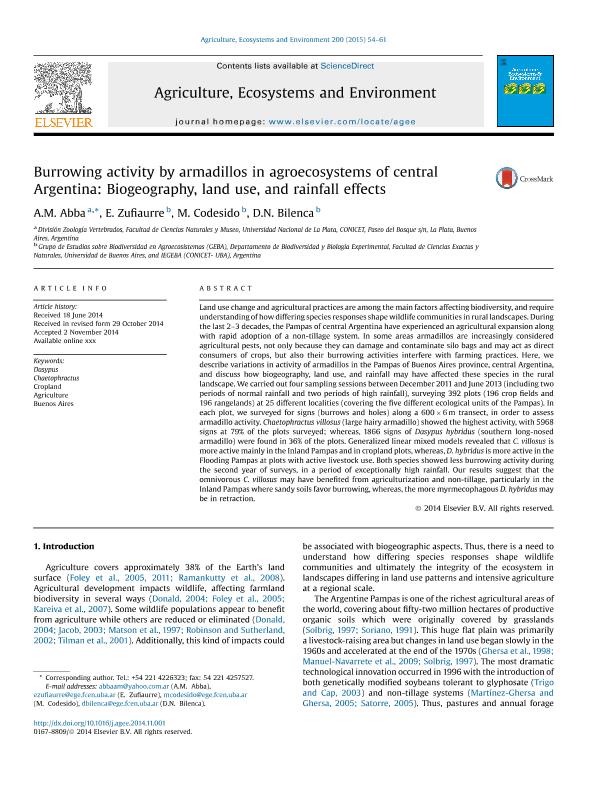Artículo
Burrowing activity by armadillos in agroecosystems of central Argentina: Biogeography, land use, and rainfall effects
Fecha de publicación:
02/2015
Editorial:
Elsevier Science
Revista:
Agriculture, Ecosystems and Environment
ISSN:
0167-8809
Idioma:
Inglés
Tipo de recurso:
Artículo publicado
Clasificación temática:
Resumen
Land use change and agricultural practices are among the main factors affecting biodiversity, and require understanding of how differing species responses shape wildlife communities in rural landscapes. During the last 2-3 decades, the Pampas of central Argentina have experienced an agricultural expansion along with rapid adoption of a non-tillage system. In some areas armadillos are increasingly considered agricultural pests, not only because they can damage and contaminate silo bags and may act as direct consumers of crops, but also their burrowing activities interfere with farming practices. Here, we describe variations in activity of armadillos in the Pampas of Buenos Aires province, central Argentina, and discuss how biogeography, land use, and rainfall may have affected these species in the rural landscape. We carried out four sampling sessions between December 2011 and June 2013 (including two periods of normal rainfall and two periods of high rainfall), surveying 392 plots (196 crop fields and 196 rangelands) at 25 different localities (covering the five different ecological units of the Pampas). In each plot, we surveyed for signs (burrows and holes) along a 600. ×. 6. m transect, in order to assess armadillo activity. Chaetophractus villosus (large hairy armadillo) showed the highest activity, with 5968 signs at 79% of the plots surveyed; whereas, 1866 signs of Dasypus hybridus (southern long-nosed armadillo) were found in 36% of the plots. Generalized linear mixed models revealed that C. villosus is more active mainly in the Inland Pampas and in cropland plots, whereas, D. hybridus is more active in the Flooding Pampas at plots with active livestock use. Both species showed less burrowing activity during the second year of surveys, in a period of exceptionally high rainfall. Our results suggest that the omnivorous C. villosus may have benefited from agriculturization and non-tillage, particularly in the Inland Pampas where sandy soils favor burrowing, whereas, the more myrmecophagous D. hybridus may be in retraction.
Palabras clave:
Agriculture
,
Buenos Aires
,
Chaetophractus
,
Cropland
,
Dasypus
Archivos asociados
Licencia
Identificadores
Colecciones
Articulos(IEGEBA)
Articulos de INSTITUTO DE ECOLOGIA, GENETICA Y EVOLUCION DE BS. AS
Articulos de INSTITUTO DE ECOLOGIA, GENETICA Y EVOLUCION DE BS. AS
Citación
Abba, Agustin Manuel; Zufiaurre, Emmanuel; Codesido, Mariano; Bilenca, David Norberto; Burrowing activity by armadillos in agroecosystems of central Argentina: Biogeography, land use, and rainfall effects; Elsevier Science; Agriculture, Ecosystems and Environment; 200; 2-2015; 54-61
Compartir
Altmétricas




